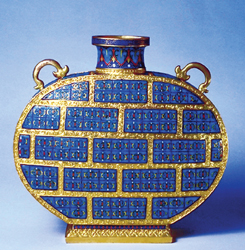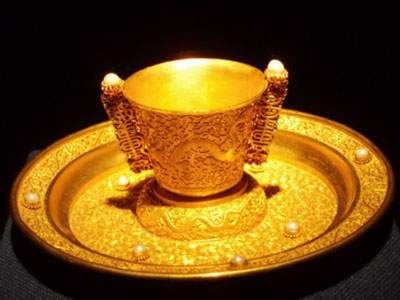The great Qing Dynasty emperors ordered exquisite artifacts to satisfy their refined taste and help cultivate a tranquil mind. Now 100 of these national treasures from Beijing's Palace Museum are showcased at Yuyuan Garden in Shanghai.
Yuyuan Garden is under high security alert these days to protect invaluable cultural artifacts from Beijing's Palace Museum in the Forbidden City.
Themed "Forbidden City Treasure," more than 100 exquisite Qing Dynasty (1644-1911) items created for the emperors' delight are on exhibit at Yuyuan Garden's Tingtao Pavilion.
"Transported in armored vehicles, their journey to Shanghai was a hurried one without stop," says Du Heping from the management office of Shanghai's Yuyuan Garden.
This is the first time many have been displayed outside the Palace Museum.
These national treasures include artifacts of jade, enamel, ceramics, lacquer, glass, ivory carvings, bamboo ware, gold and silver. They once were appreciated by the emperors of the Qing Dynasty, such as Kangxi, Yongzheng and Qianlong, all known for their refined taste.
The reigns of these first three great emperors were a time of peace for China and a time when the arts flourished.
"Made by imperial order, the artifacts mainly satisfied the emperors' and the royal families' desire to cultivate a peaceful mind and inner tranquility, culture, entertainment and a rich life," Du says. "The three emperors shared something in common, that is, having a refined mind that pursued perfection. No wonder the artworks were infused with their love of beauty."
The exhibits include porcelains that demonstrate the highest level of Chinese porcelain art and drinking glasses made with shimmering powdered gold. All of the items are small and delicate, intricately wrought by China's master craftsmen of the time.
One of the highlights is a red peach-shaped box, a treasure of Emperor Yongzheng. At first glance it may appear to be red lacquer, but it is actually red coral, exquisitely carved in a design of nine dragons in the clouds.
The jade on display perfectly reflects the sensibilities of the Qing Dynasty. Emperor Qianlong's two jade seals were ordered by him at his 70th and 80th birthdays. Another treasure is a white jade seal called "Ji En Hall Treasure," expressing the affection between his grandfather Kangxi and grandson Qianlong.
To hand down Kangxi's love and kindness for generations, Qianlong wrote two articles, recording the whole story between them. Then he appointed imperial craftsmen to carve two seals with the two articles inscribed on each.
"These cultural relics are so precious that the Palace Museum sent many staff to check on them. Even the slightest deficiency in any exhibit will be noted down," Du says.
Yuyuan Garden's management office is providing super security. In addition to infrared rays and sound-sensitive burglar alarms, more than 10 cameras constantly monitor the entire site.
For visitors, the exhibition offers a rare opportunity to appreciate national treasures first-hand. This is the second time that treasures from the Palace Museum have been showcased in the city.
The first exhibition two years ago featured watches and clocks and fueled the admiration of cultural relics among residents.
"Though China is no longer ruled by emperors, the treasures feature the flavor of a strong royal culture," Du says. "Appreciating them is a great way to exalt Chinese culture. Expats who had only read about these treasures and seen pictures of them now can see them with their own eyes."
Date: through December 10, 8:30am-5pm
Venue: Tingtao Pavilion, Yuyuan Garden, 218 Anren Rd
Admission: 40 yuan (includes other Yuyuan Garden attractions)
(Shanghai Daily September 25, 2007)



